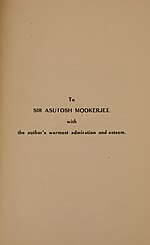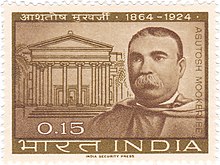Ashutosh Mukherjee
Vice Chancellor of Calcutta University | |
|---|---|
| In office 4 April 1921 – 3 April 1923 | |
| Preceded by | Nilratan Sircar |
| Succeeded by | Bhupendranath Basu |
| In office 31 March 1906 – 30 March 1914 | |
| Preceded by | Alexander Pedler |
| Succeeded by | Devaprasad Sarvadhikary |
| Personal details | |
| Born | 29 June 1864 Vice-Chancellor of the University of Calcutta Judge of the Calcutta High Court (1903–1924) |
| Awards | Knight Bachelor (1911) Companion of the Order of the Star of India (CSI, 1909) |
Mukherjee also played a vital role in the founding of the University College of Law popularly known as
He is often called "Banglar Bagh" ('The Bengal Tiger') for his high self-esteem, courage and academic integrity.
Early life
Ashutosh Mukherjee was born on 29 June 1864 at Bowbazar, Kolkata in a Brahmin family to Jagattarini Devi and Ganga Prasad Mukhopadhyaya, a well-known doctor who founded the South Sub Urban School in Calcutta. Among his ancestors were several distinguished Sanskrit scholars, including Pandit Ramchandra Tarkalankar, a professor of nyaya who had been appointed by Warren Hastings to that chair at the Sanskrit College in Kolkata.[7] Brought up in an atmosphere of science and literature at home, young Ashutosh went to the Sisu Vidayalaya at Chakraberia, Bhowanipore and showed an early aptitude for mathematics. When he was young, he met Ishwar Chandra Vidyasagar who was a major influence on him. He was a student of Madhusudan Das.[8]
Personal life
Mukherjee married Jogamaya Devi Bhattacharyya (1871–16 July 1958) in 1885.
Family history
Sir Ashutosh Mukherjee was born into a Hindu Brahmin family in
Accomplishments as a mathematician
In November 1879, at the age of fifteen, Mukherjee passed the entrance exam of the
In 1883, Mukherjee topped the BA examination at
Mukherjee continued publishing scholarly papers on mathematics and physics into his 30s. By 1893, aged 29, Mukherjee had been further elected to the fellowships of the Physical Society of France and the Mathematical Society of Palermo, and was a member of the Royal Irish Academy. He subsequently became a member of the London Mathematical Society, the Paris Mathematical Society and the American Mathematical Society (1900).[2][15] Although after 1893 he largely abandoned his mathematical pursuits for a legal career, Mukherjee has been recognised as the first modern Indian mathematician to enter the field of mathematical research, and founded the Calcutta Mathematical Society in 1908. Among his mathematical contributions, Mukherjee determined several crucial derivations of Gaspare Mainardi's answer to determining the oblique trajectory of a system of confocal ellipses. He also made lasting contributions in differential geometry, developing analytical methods of simplifying Gaspard Monge's interpretation of his general differential equation for conics.[2][15]
Lawyer, jurist and educationist

At the age of 24, Mukherjee became a Fellow of the Calcutta University. Turning down a job offer in the Department of Public Instruction in order to complete his Bachelor of Law degree, he received his degree in 1888 and enrolled as a vakil of the Calcutta High Court. By 1897, he had received an
Mukherjee was influential in the university affairs throughout his life. From the age of 25, he was a member of its Syndicate, serving on the University Senate and Syndicate for the next 16 years. He served as President of the Board of Studies in Mathematics for 11 years, and represented his university in the
Had this Bengal Tiger been born in France, he would have exceeded even Georges Clemenceau
Academic career and later life
Ashutosh Mukherjee had a vision of the kind of education he wanted young people to have, and he had the acumen and courage to extract it from his colonial masters. He set up several new academic graduate programs at the Calcutta University:
Curzon's education mission in 1902 identified the universities including the Calcutta University, as centres of sedition where young people formed networks of resistance to colonial domination.[18] The cause of this was thought to be the unwise granting of autonomy to these universities in the nineteenth century. Thus in the period of 1905 to 1935, the colonial administration tried to reinstate government control of education.

In 1910, he was appointed the president of the
After serving five terms as vice-chancellor of Calcutta University, Mukherjee declined to be reappointed to a sixth term in 1923 when the university's chancellor,
Recognition and legacy


Mukherjee was a polyglot learned in Pali, French and Russian. Apart from his fellowships and memberships in several international academic bodies, he was recognised by an award of the title of Saraswati in 1910 from pandits in Nabadwip, followed by that of Shastravachaspati in 1912 from the Dhaka Saraswat Samaj, Sambudhagama Chakravarty in 1914 and Bharat Martanda in 1920.[1] Mukherjee was appointed a Companion of the Order of the Star of India (CSI) in June 1909,[20] and knighted in December 1911.[21]
In his lifetime, he was appointed to numerous academic societies:
- Fellow of the Royal Astronomical Society (FRAS, 1885)[1]
- Fellow of the Royal Society of Edinburgh (FRSE, 1886; Member: 1885)[1]
- Member of the Bedford Association for the Improvement of Geometrical Teaching (1886)[1]
- Fellow of the Physical Society of London (FPSL, 1887)[1]
- Fellow of the Edinburgh Mathematical Society (1888)[1]
- Membre de la Société mathématique de France (1888)[1]
- Member of the Circolo Matematico di Palermo (1890)[1]
- Membre de la Société française de physique (1890)[1]
- Member of the Royal Irish Academy (MRIA, 1893)[1]
- Fellow of the American Mathematical Society (AMS, 1900)[1]
The Government of India issued a stamp in 1964 to commemorate Sir Ashutosh Mukherjee for his contribution to education.
The epitaph beneath his marble bust at the Asutosh Museum of Indian Art at the University of Calcutta reads:
His noblest achievement, surest of them all/ A place for his mother tongue --- in step mother's hall.
References
- ^ a b c d e f g h i j k l Sar, Satyabachi (July 2015). "Asutosh Mukhopadhyay and his Mathematical Legacy". Resonance: Journal of Science Education. 20 (7): 575–604. Retrieved 23 June 2019.
- ^ a b c d e f "The mathematician in Asutosh Mukhopadhyay" (PDF). Current Science. Retrieved 29 September 2017.
- ^ "Calcutta Mathematical Society". Calmathsoc.org. Archived from the original on 31 May 2012. Retrieved 12 July 2012.
- ^ "Asutosh Mukhopadhyay: An eminent educator who made Bengalis proud".
- ^ Dutta, Ashis (29 June 2013). "First in class". The Hindu.
- ^ "Sir Ashutosh Mukherjee: educationist, leader and institution-builder" (PDF). Current Science. Retrieved 29 September 2017.
- ^ "Our History". mslawcollege.org. 2012. Retrieved 28 April 2012.
Ashutosh Mukherjee, the then Vice-Chancellor of Calcutta University who was a student of Utkal Gourab Madhusudan Das
- ^ "Shrimati Jogmaya Devi Passes Away". The Calcutta Municipal Gazette. 68 (13): 301. 19 July 1958. Retrieved 26 December 2021.
- ^ Indian Association for the Cultivation of Science: Annual Report for 1983-84. 1984. p. 3.
- ISBN 9789350488812.
- ^ "Grandson of Sir Ashutosh Mukherjee upset at Mamata's silence on letter". The Times of India. 25 March 2013. Retrieved 15 May 2018.
- ISBN 978-981-19-6132-8.
- ^ a b Ghatak, Atulchandra, Ashutosher Chatrajiban Ed. 8th, 1954, p 1, Chakraborty Chatterjee & Co. Ltd.
- ^ a b c d e f g h i j "Sir Asutosh Mukherjee: educationist, leader and institution-builder" (PDF). Current Science. Retrieved 29 September 2017.
- ^ Rachana Chakrabarty (2012). "Premchand Roychand Studentship". In Sirajul Islam; Ahmed A. Jamal (eds.). Banglapedia: National Encyclopedia of Bangladesh (Second ed.). Asiatic Society of Bangladesh.
- ^ IACS - Annual Report for the Year 1888
- ^ Aparna Basu (1974) The Growth of Education and Political Development in India, 1898–1920, New Delhi: Oxford University Press.
- ^ "IACS - Annual Report for the Year 1924" (PDF). Archive - IACS. Retrieved 2 October 2017.
- ^ "No. 28263". The London Gazette (Supplement). 22 June 1909. p. 4855.
- ^ "No. 28559". The London Gazette. 8 December 1911. p. 9365.
